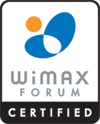
ARQ
Broadband wireless access systems are expected to operate in environments that are often characterized by severe fading and interference conditions, which render physical layer error-correction coding schemes (such as FEC) insufficient. The use of automatic repeat-request (ARQ) mechanisms is a well-known technique to handle transmission errors, which occur when data is transmitted over noisy channels. ARQ schemes rely on a feedback control channel to acknowledge packet reception by the receiver; packets received in error are retransmitted at the data-link layer, which makes the link appear error-free to higher layer protocols.
The existence of an ARQ scheme at the MAC layer is particularly important for the performance of flow control protocols, such as TCP. When TCP operates over links with relatively high error rates, it may experience severe performance degradation. TCP employs a sliding window algorithm to control the amount of outstanding (and unacknowledged) data in order to detect and react to network congestion. A traffic source increases its TCP window size until a packet loss is detected. At this point the source reduces the window size and the cycle repeats. In wireless networks, however, packet loss may frequently be due to link-level errors caused by channel impairments. It has been shown that the effective throughput of a TCP connection decreases as the probability of packet loss increases, because of the re-transmissions at the TCP layer. ARQ addresses this problem by triggering re-transmissions at the MAC layer, which make the link appear error free to the TCP layer. The Aperto system implements ARQ in hardware, which allows it to do several re-transmissions within duration of tens of milliseconds. This facility is very important, because if the TCP packet is not recovered within half a second, the TCP source times out and re-transmits the packet.
In what follows, we present measured results using the Aperto® system, that illustrate the importance of ARQ mechanism on fixed wireless systems. Given that most of the popular Internet applications use TCP as the preferred flow control algorithm, our performance measure is TCP throughput; we compare the performance of flows running over ARQ against flows running without ARQ support.
The average TCP throughput rate and the MAC packet error rate were measured for a set of SNR values, with the modulation level fixed at 16QAM. Two different FEC coding levels were assigned, referred to as Low and High FEC. High FEC offers more protection at the cost of increased overhead. Figure 2 plots the normalized TCP throughput rate versus the packet error rate, with and without ARQ. The improvement observed when using ARQ is impressive. With ARQ, the system is capable of sustaining packet error rates up to 10 times higher, for an equivalent throughput.


